How to Do Competitor Research in Less than 30 Minutes?
Table of contents
Time is precious in a marketer’s life, and traditional competitor analysis can be time-consuming. Lucky us, AI tools have transformed this process, providing quick and accurate insights.
For example, using Brand Assistant (inside the Brand24 tool), I analyzed Spotify’s market position. The data showed that Spotify had a reach of 7.3 billion, much higher than Tidal’s 628.5 million. It also showed that Tidal has 10% negative sentiment, while Spotify has only 3%. It turned out that Tidal is somehow linked with completely irrelevant topics!
This AI analysis offers Tidal insights to fine-tune its presence in these places. That’s just one aspect of competitor research and it offers so much more!
Let’s dive deeper, shall we?
Competitor research is the process of identifying and analyzing your competitors’ strengths and weaknesses to improve your own business strategies. It helps you understand market trends, spot opportunities, and stay ahead of the competition. This is done by gathering data through tools, surveys, and direct comparisons.
Table of contents:
- What is competitor research? Definition
- Purposes of competitor research
- How to do competitor research?
- Challenges in competitor research
- Conclusion
What is competitor research? Definition
Competitors’ research involves identifying their strengths and weaknesses, evaluating their products or services to understand the market, and finding ways to set your business apart.
Analyzing the products and services of your main competitors can provide valuable insights into the target market and industry trends.
Conduct competitor research!
Purposes of competitor research
Conducting a competitive analysis holds great potential for improving your own insights.
When I was a teenager, I loved crafts and made many of them. However, I needed money to buy materials. That’s when I had the fantastic idea of opening an online shop on Etsy.
I was pretty sure that I wouldn’t have problems selling my work, but what I didn’t predict was that I wouldn’t be able to keep up with producing new ones.
I wondered, “How can I make this work?” and decided to take a look at other similar small businesses. I realized that most people don’t paint each pattern once but keep repeating them. That was the game-changer!
I incorporated this idea into my “business strategy” and kept doing a great job.
You may think this example is silly, and yep, I agree. Perhaps I shouldn’t compare a teenager’s little artsy shop with a REAL BIG business.
But isn’t the process similar? The benefit of a competitor analysis is clear.
Just on a different level 😉
What else can a competitive analysis give you?
Here’s a list of benefits of a competitor research:
- You gain a clear understanding of where your direct competitors excel and where they falter, allowing you to identify opportunities for improving your marketing strategy and brand awareness.
- It’s a fantastic way to learn about the latest trends, consumer preferences, and demands within your industry, helping you to stay relevant and responsive.
- It lets you identify potential threats from direct competitors early, giving you time to develop strategies to counteract them effectively.
- You can discover gaps in your competitors’ offerings.
- You can meet the needs of your own target audience better by analyzing how competitors interact with their customers (including competitors customer service and their marketing strategies).
- It enables to set benchmarks based on competitors’ performance to measure your own growth and success and ensure you maintain or exceed industry trends.
- It’s possible to recognize more efficient processes and practices used by competitors, which can streamline your own business operations and reduce costs.
- You can learn from the effective sales strategies of competitors to enhance your own sales process and increase market share.
- It allows you to understand where competitors are investing (new technologies, markets, or customer segments) to inform your own investment decisions.
So, now that you (most probably) want to do a competitive analysis – let me explain how to do it.
Get insights about your competitors!
How to do competitor research?
There are many ways to do market research, from the least efficient – manual analysis to the most effective…
Hah, got you!
Did you really think it would be just one option?
A detailed competitive analysis is a complex process. I divided it into 3 steps:
Step 1 Ask AI tools
AI still has its lovers or haters… But it undoubtedly speeds up the tasks we would do much longer. In fact, competitive analysis is one of them. The key is to ask the right questions and use advanced tools.
So, ready for a quick test?
I wanted to find information about the direct and indirect competitors to Spotify, find key competitors to Spotify and identify market gaps in the music industry.
These are the questions I asked:
- Who are Spotify’s key competitors?
- How does the music streaming market landscape look like?
- How does Spotify’s sentiment look like compared to Tidal?
ChatGPT
Here’s what the answers of ChatGPT 4.0 look like.
- “Who are Spotify’s key competitors?”
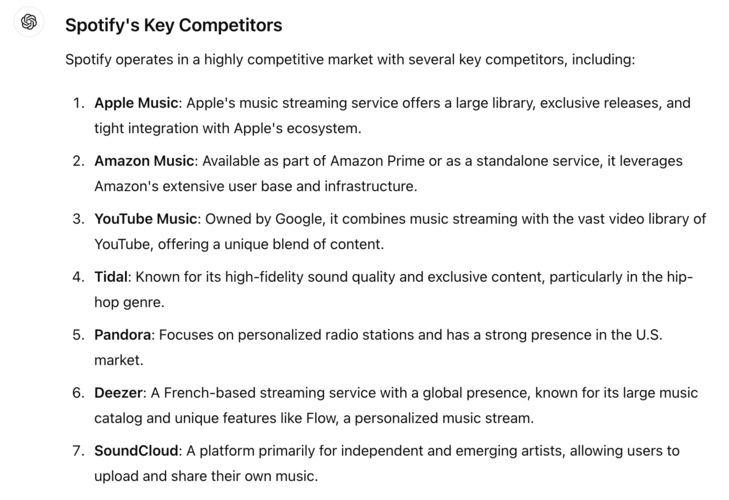
The competitors it listed are very accurate, and include some less obvious brands – for example, I wouldn’t find Deezer, it’s a quite specific platform.
- “How does the music streaming market landscape look like?”
The second answer isn’t satisfying to me. I feel like it’s very general, while I expected some hard data in competitive analysis:
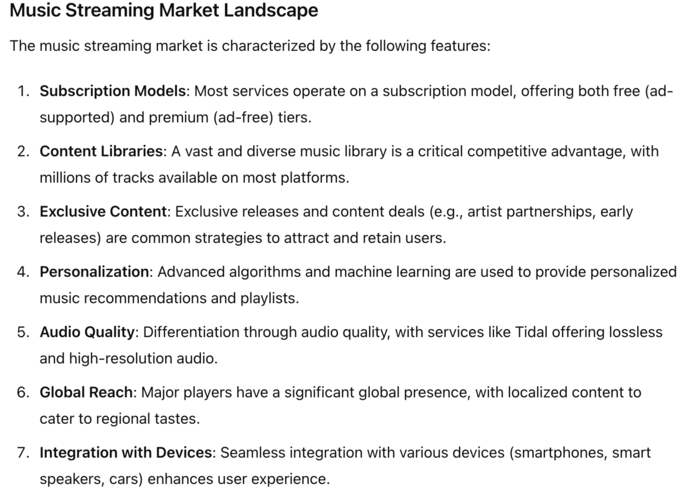
And here’s a final answer:
- “How does Spotify’s sentiment look like compared to Tidal?”
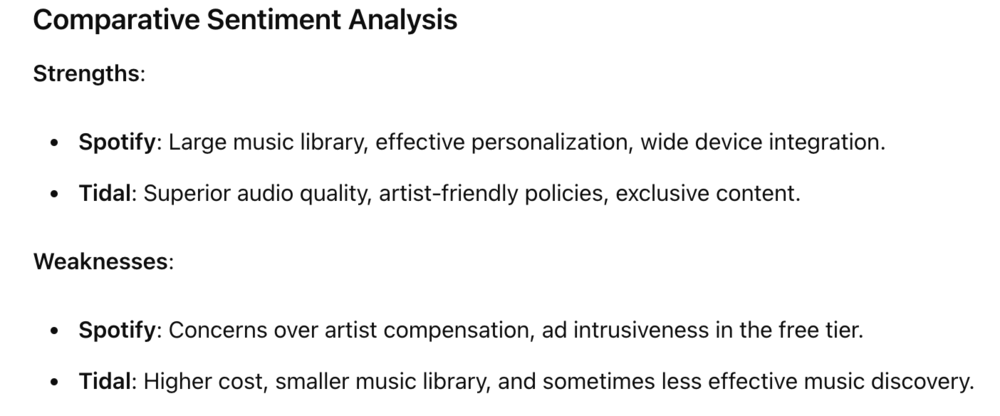
This one is quite interesting, but again – super general. Plus, it didn’t provide any actual data.
However, doing a similar competitive analysis manually would take me much longer than 5 minutes, which is exactly how much time I spent on writing these questions and getting answers.
Try Brand24’s AI features!
Perplexity
- “Who are Spotify’s key competitors?”
I like that this tool also provided links to resources so I can easily double-check the information.
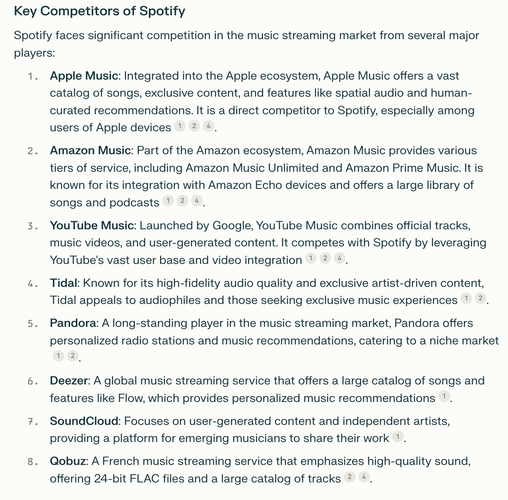
- “How does the music streaming market landscape look like?”
This is a more detailed answer on competitive market research. I like the fact that it didn’t provide just the topics but also the specific brand that covers it.
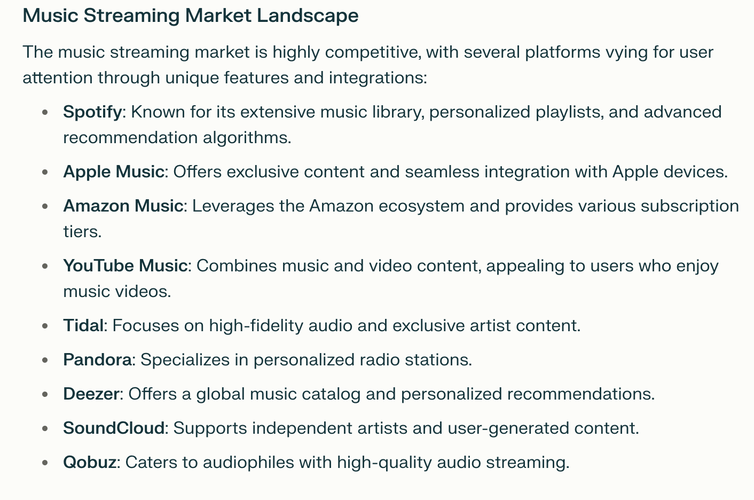
- “How does Spotify’s sentiment look like compared to Tidal?”
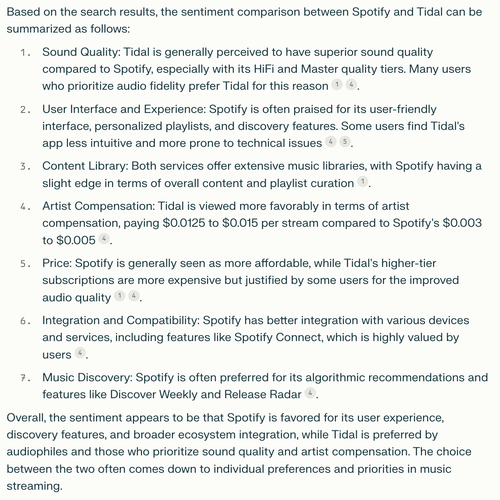
So, as you can easily see, these well-known AI tools are mainly based on search engine data. They will not correctly answer the question of real time data or specific data-driven analysis.
That’s where Brand24’s Brand Assistant comes in handy as it combines the data from the media monitoring tool with ChatGPT “knowledge”.
Brand Assistant
This feature is super similar to the previously mentioned tools. It’s also based on a chat where you ask questions (prompts) to get the answers.
But the main difference is that Brand Assistant is based on data from monitored projects and can present conclusions, insights, and competitive analysis report that ChatGPT and Perplexity won’t. These two tools only give general conclusions and recommendations.
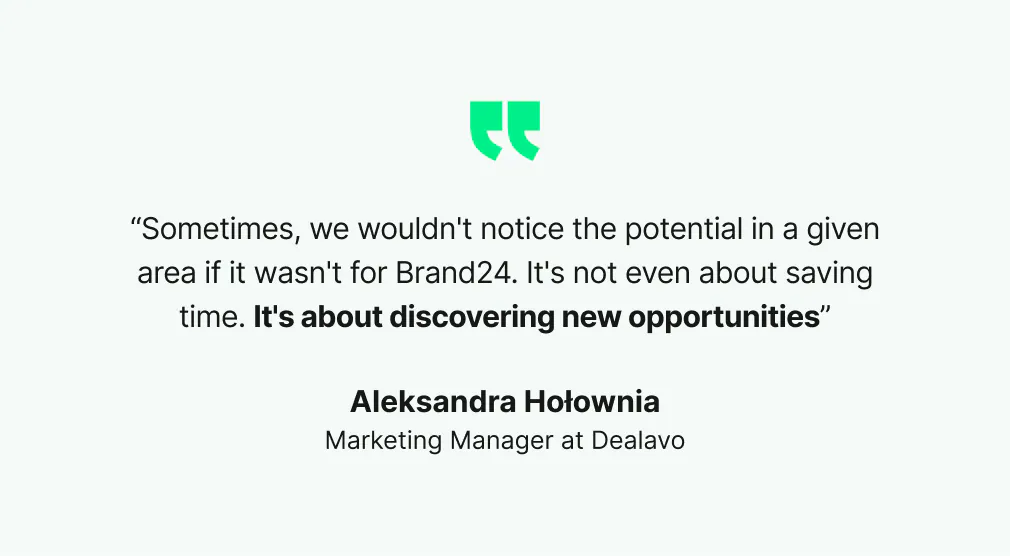
Discover our client’s success story — read the case study.
In terms of competitive analysis it’s a super powerful tool, but to harness its full potential – you need to set up projects also for your competitors.
That way the tool will combine the monitoring data of your brand, your competitors and the general knowledge that ChatGPT has.
Get AI Brand Assistant!
These are the answers from the Brand Assistant:
- “Who are Spotify’s key competitors?”
Brand Assistant uses real-time data from monitored projects to present a comprehensive list of competitors. This ensures accuracy and relevancy, offering a more detailed and up-to-date competitive landscape.
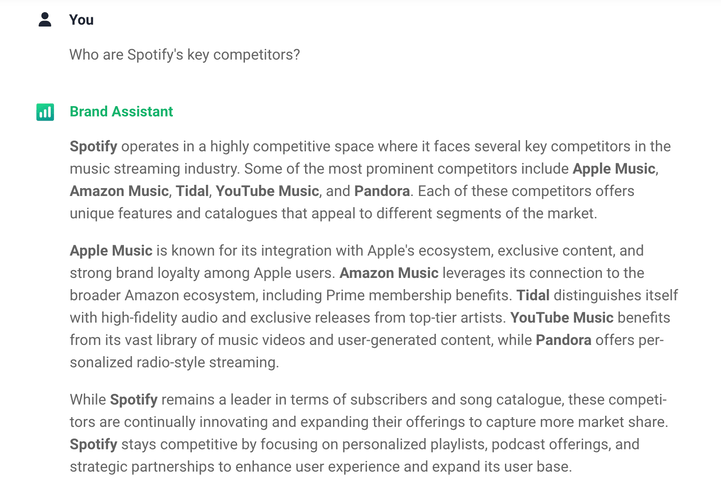
- “How does the music streaming market landscape look like?”
While ChatGPT and Perplexity offer broad and general answers to this question, Brand Assistant provides specific, data-driven insights.
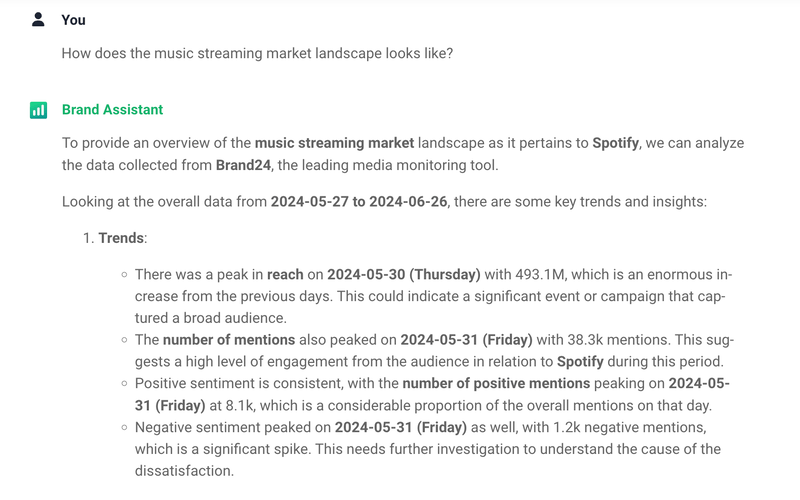
By combining media monitoring data with AI, Brand Assistant delivers a nuanced view of the market landscape, highlighting key players, emerging trends, and potential market gaps with greater accuracy and detail (and actual numbers!).
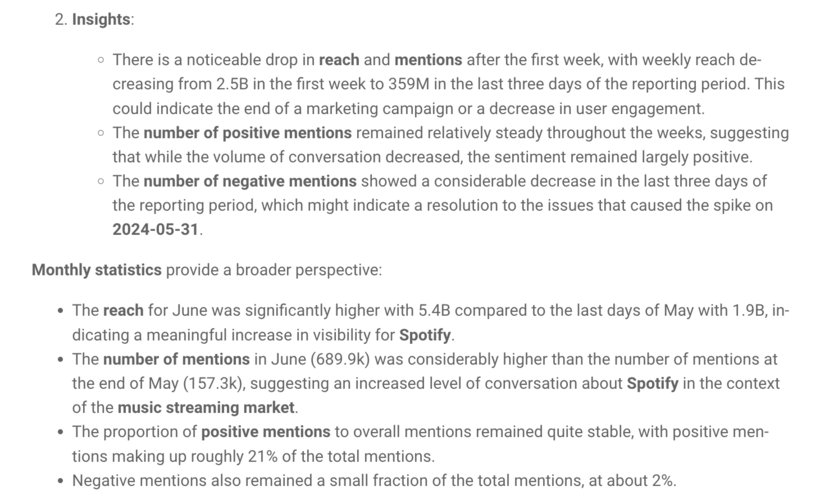
- “How does Spotify’s sentiment look like compared to Tidal?”
Brand Assistant stands out in sentiment analysis by using real-time data to compare Spotify’s sentiment with Tidal’s.
Unlike the general and often non-specific responses from ChatGPT and Perplexity, Brand Assistant offers detailed sentiment analysis based on current media monitoring data.
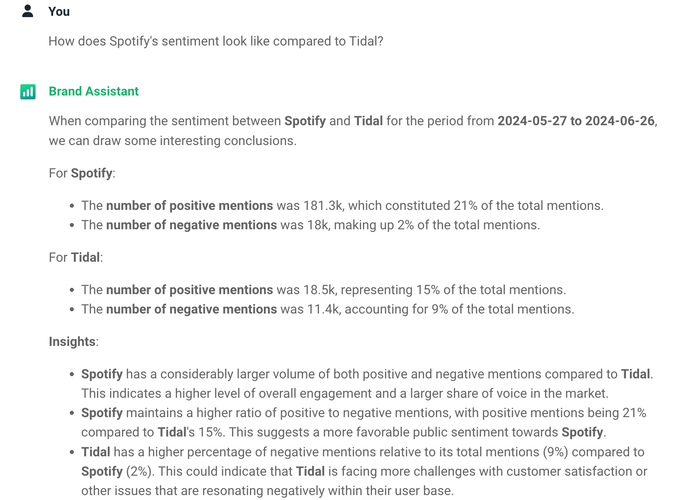
Plus, it even generated a chart to present this sentiment competitor analysis:
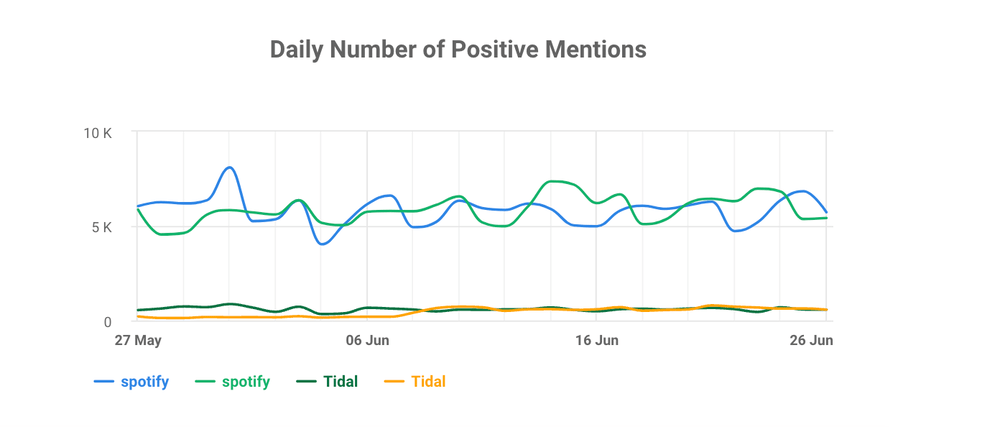
Want to test it for yourself?
Analyze your competitors using AI!
Here’s a ready-to-use list of prompts for Brand Assistant:
- How does [your brand]’s user growth compare to [competitors] in the past quarter?
- How does the public sentiment towards [your brand] compare to that of [competitors] on social media platforms?
- Has there been a noticeable shift in the number of negative mentions by [your brand] compared to [competitors]?
- What trends are emerging in [your industry] preferences, and how are [competitors] adapting to these trends?
- Are there any significant partnerships or collaborations that [competitors] have engaged in that could influence [your brand]’s position in the market?
- What is the geographic market penetration of [your brand] versus competitors, and are there new markets that competitors are tapping into effectively?
- What is the level of brand loyalty for [your brand] users compared to those of other services, such as [competitors]?
- How did the sentiment of [your brand] changed during the last 3 months and compare it to [competitors]?
Try Brand Assistant!
Step 2: Ask the target audience
Next, it’s time to go straight to the source: your target audience.
Talking directly to the people you’re trying to reach can provide valuable insights that no AI tool can match.
Yes, it’s more time-consuming than AI analysis, but the insights you gain can be incredibly valuable and more focused on your brand.
Tips for conducting effective interviews:
- Make sure your questions are clear and directly related to the information you need.
- Combine online surveys, face-to-face interviews, and focus groups to get a well-rounded view.
- Encourage participation by offering small rewards, such as discounts or freebies.
- Look for patterns and trends in the responses to gain actionable insights.
- Avoid leading questions to ensure you get honest, unbiased feedback.
By engaging with your audience, you can uncover hidden preferences, frustrations, and needs.
This step, though time-intensive, can help tailor your strategies to better meet your audience’s expectations, setting you apart from your competitors.
Conduct competitor research!
Step 3: Benchmark with competitor
The final step I’ll discuss is benchmarking the results of your competitor research with a competing brand/product/company, etc.
Why is this important, and what value does it provide?
Benchmarking against your competitors helps you understand where you stand in the market.
By analyzing their strengths and weaknesses in relation to your own, you can identify competitive advantage, opportunities for improvement, and areas where you already excel.
This comparison is crucial for setting realistic goals and developing strategies that leverage your own business competitive advantage.
But how to do it?
The easiest way is by using competitor analysis tools.
For example, using the Comparison tab in Brand24, you can directly compare key metrics such as:
- Mentions
- Sentiment
- Social Media Reach
- Non-social Reach
- Online Presence Score
- Advertising Value Equivalency (AVE)
- UGC (user generated content)
- Share of Voice
This competitor analysis highlights where your direct competitors are performing well and where they might be falling short, giving you a clear picture of the competitive landscape.
Here’s what it looks like for Spotify and its competitors:
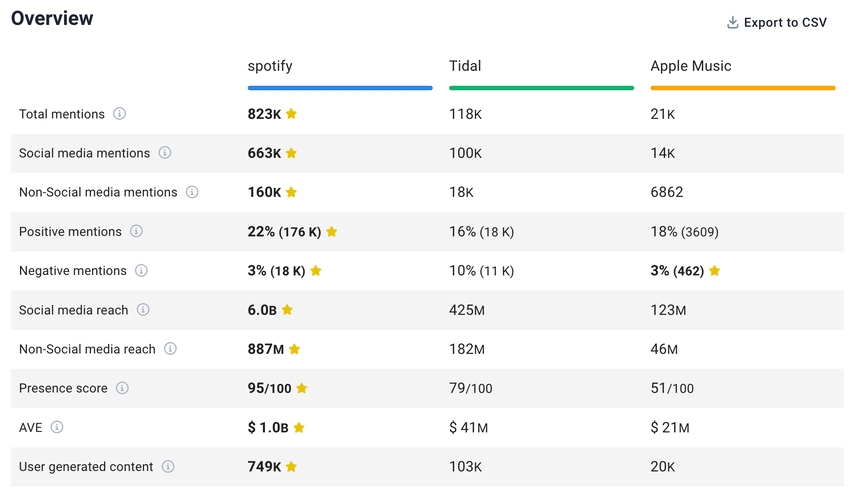
As you can see, Spotify is ruling the music streaming industry!
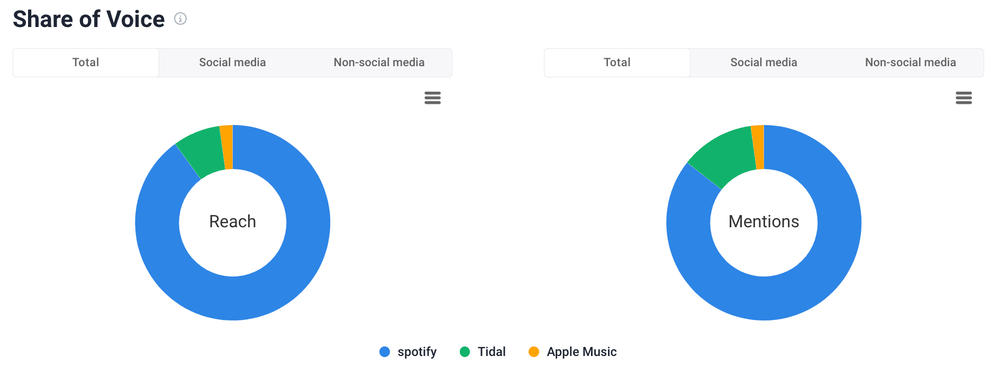
However, these stats are pretty dry. I personally love to understand the “why” behind them.
Research your competitors!
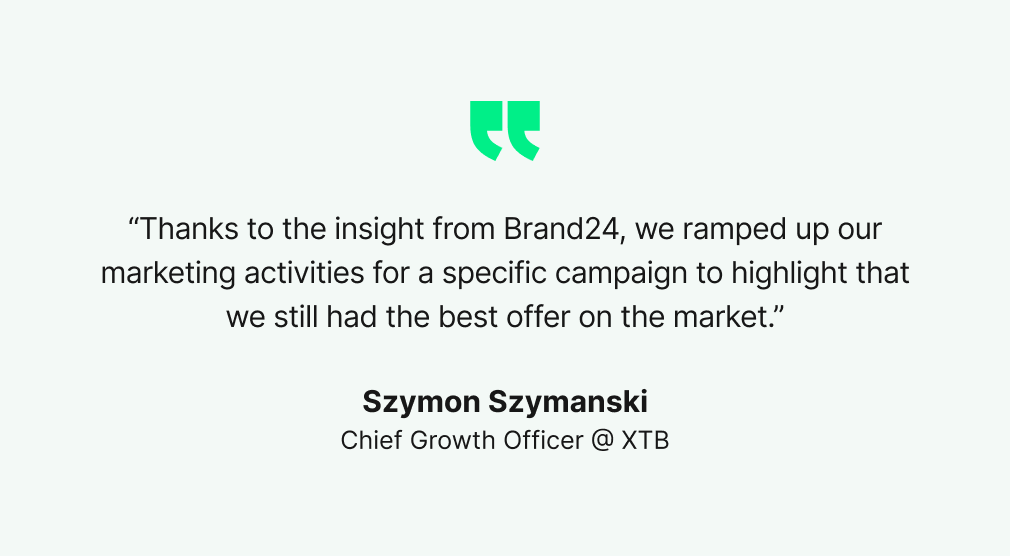
Discover our client’s success story — read the case study.
So why not ask the Brand Assistant?
Let’s find out what’s behind the negative brand mentions of Spotify and why Tidal has so many of them.
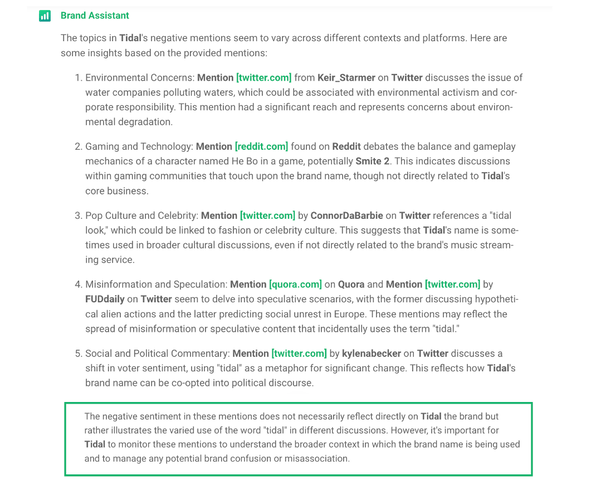
It turns out that Tidal’s problem might not be directly related to the service itself but to how the brand is associated with other negatively charged topics.
Isn’t it interesting?
I think the recommendation from Brand Assistant to monitor those mentions even though not having direct link to their service is a great tip. These are some dangerous spheres for the brand and it’s best to be aware how these conversations emerge. It can help to prevent a potential PR crisis.
Let’s now use it as a competitor analysis tool. I asked “How Spoify’s sentiment compares to Tidal’s during the last month?”
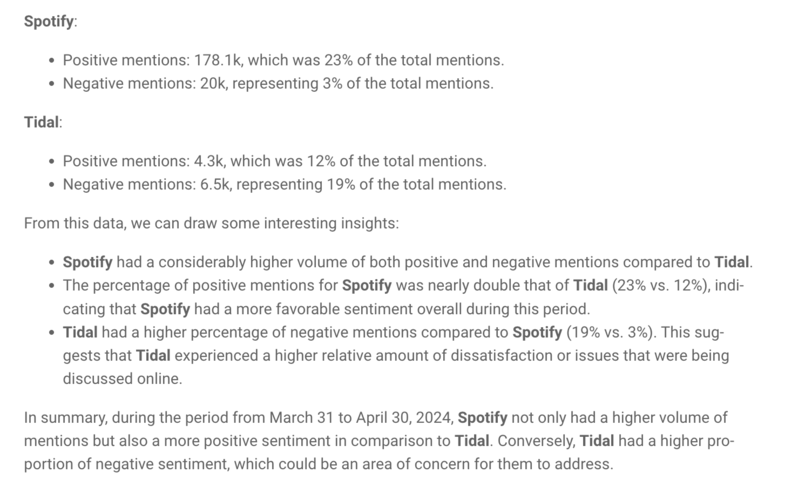
And as you can see, it did an amazing job!
Normally I’d have to spent at least an hour to compare this data (even having projects in a social listening tool for both brands).
But the Brand Assistant counted everything and gave me a clear analysis in less than 3 minutes.
Try AI Brand Assistant!
Challenges in competitor research
Competitive analysis is a complex process that has its limitations. However, being aware of some challenges makes it easier to overcome them.
That’s why I curated a list of potential challenges in competitor analysis:
- Data availability and accuracy
Finding reliable and up-to-date data on competitors can be difficult as the publicly available information may be limited and outdated. - Interpreting data correctly
Analyzing large volumes of data requires expertise and is a crucial part of competitive analysis. Misinterpretation can lead to incorrect conclusions and marketing strategies. - Resource intensive
Conducting thorough competitor research can be time-consuming and costly. That’s why smaller businesses may lack the resources for comprehensive competitive analysis. - Rapid market changes
The market landscape can change quickly, making it hard to keep research current. - Bias and subjectivity
Personal biases can influence how data is interpreted and used. - Access to proprietary information
Some valuable competitor information is proprietary and not publicly accessible. This limits the scope of analysis and insights that can be gathered. - Legal and ethical concerns
Gathering a competitive edge must be done legally and ethically. And avoiding practices that could lead to legal issues or damage reputation is crucial. - Changing consumer preferences
Understanding and predicting shifts in competitors’ markets can be complex. Plus, competitor strategies may not always be aligned with these changes. - Technological advancements
Staying updated with technological changes that affect the industry is essential. At the same time, competitors may adopt new technologies faster, creating a gap. - Integration of insights
Effectively integrating competitor insights into your strategy can be challenging. They change really fast, and sometimes, it’s hard to even identify gaps, not to mention address them.
Conduct competitor research!
Conclusion
In today’s fast-paced marketing world, competitor analysis isn’t just important – it’s crucial for staying ahead of the game and keeping up with industry trends.
I think using AI tools is the best thing you can do.
With their help, you can easily identify market trends, understand your competitors’ strengths and weaknesses, and uncover new opportunities for growth.
These tools provide valuable data that can help you stay ahead of the competition, fine-tune your marketing strategies, and enhance your brand’s market share.
Curious about real-world case studies? Dive deeper into how global giants like Amazon, Boeing, Uber, and Airbnb battle for market dominance.
Final thoughts:
- Competitor analysis is a crucial part of any successful business strategy. It ensures you remain aware of the target market, adapt to changes quickly, and maintain a competitive advantage.
- AI tools save time and provide much more precise insights that manual analysis cannot match. They are indispensable for modern competitor analysis.
- Tools like Brand Assistant can give you more than general recommendations. They can analyze detailed, real-time data, conduct sentiment analysis, and so much more!
Ready to transform your competitor research process?
Start your free trial with Brand24 today and see the difference AI-powered insights can make!



